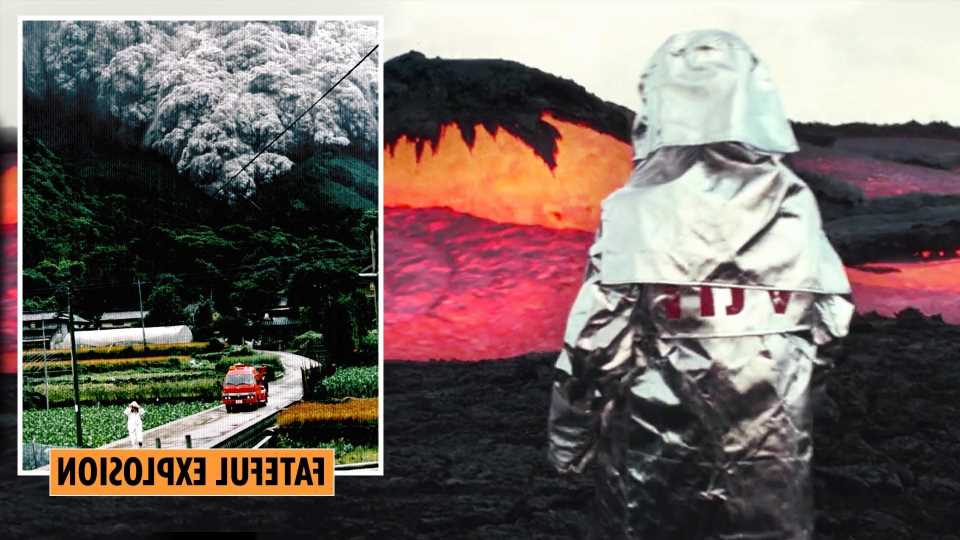
Incredible life of ‘volcano chasers’ who dipped FEET in lava and eerily predicted their tragic deaths in freak explosion | The Sun
August 7, 2022IN June 1991, a volcano which had been dormant for over 300 years violently erupted, wrecking havoc on everything that stood in its path.
The deadly explosion of Japan's Mount Unzen claimed the lives of 43 people, including volcanologists Maurice and Katia Krafft, who had dedicated their entire lives to studying the dangerous ruptures.
Jaw-dropping images of the blast show the a huge ball of toxic gas it spewed into the atmosphere.
Maurice, 45, and Katia, 49, were caught in the unpredictable pyroclastic flow – a chaotic mixture of rock fragments, hot gas and ash, that can travel at astonishing speeds – that unexpectedly engulfed a ridge they'd been sheltering on.
Studies of the earth in its aftermath revealed that the couple died next to each other – exactly where they had always been ever since they met.
Knowing how far they were prepared to go to feed their insatiable curiosity for volcanoes, the pair had eerily predicted they would one day meet such a devastating fate.
READ MORE FEATURES
I hired kidnapper to snare daughter’s killer – but some felt I was the villain
I spent £43k to look like my idol Pamela Anderson – blokes always say same thing
A new National Geographic documentary called Fire of Love shares a fascinating insight into the daredevil couple's lives.
It features recordings made during their missions chasing after dangerous wonders of the world.
In one, Maurice chillingly states: "I want to get closer, right into the belly of the volcano. It will kill me one day, but that doesn't bother me at all."
Katia shared the same sentiment: "It is not that I flirt with death, but at that moment, I don't care at all. A fascination with danger? Perhaps."
Most read in News
Girl, 11, drowns at waterpark after vanishing 'during friend’s birthday party’
Archie's mum reveals pride in son, 12, after he dies & family share new pic
Archie dies after life support turned off as mum sobs 'he fought til the end'
12 tourists killed as bus skids off motorway after driver 'falls asleep'
Fiery passion
 17
17 17
17Although there are three different accounts of how the Alsatian French duo met, the most detailed suggests they got together during a speed dating event in the 1960s.
They bonded over their shared love for Mount Etna in Italy, one of the world's most active volcanoes.
They tied the knot in a small ceremony and went on honeymoon to Santorini, a volcanic Greek island in the southern Aegean Sea.
To devote their time and effort to their expeditions, they decided never to have kids.
In the years that followed, they embarked on risky tours, with their desire to get as close as possible to fiery red lava growing with every trip.
I want to get closer, right into the belly of the volcano. It will kill me one day, but that doesn't bother me at all
"Once you see an eruption, you can't live without it because it's so grandiose, it's so strong," Katia said.
"That feeling of being nothing at all. Being in these untamed elements."
Maurice and Katia were in their element and at their happiest when exploring volcanoes.
After an eruption the couple would often be first on the scene, thanks to an expansive network of local friends and fellow volcanologists – making them the envy of others in their field.
In one scene of the film, they are seen happily dancing on the edge of a hot flow of lava, which could pass for a green screen scene in a big budget Hollywood movie.
Another heart-stopping moment sees Maurice's foot set ablaze after he dips it in cooling lava.
Their passion for danger was famous – in one recording Katia admitted some of their colleagues thought they were "weirdos".
'Approaching the beast'
During one of their trips, in 1979, the volcano they visited was so violent they had to keep watch at night for 'volcano bombs' – balls of molten rock that can cause life-threatening injuries and death.
Clearly unfazed, Maurice explained: "There is the pleasure of approaching the beast, not knowing it it will catch you."
The couple knew they had to work as a strong unit, as one wrong move by either of them could spell disaster.
Maurice said: "One needs to have strong nerves and not panic easily.
"Let's say my wife gets injured. There's nothing I can do. I'm with her as she's dying, and I can't do anything. It's horrible."
Katia was the more practical of the pair, while Maurice would often venture off in the search of further thrills.
He had dreams of sailing on scorching lava in a canoe for 15km – an idea which stemmed from another perilous adventure in Indonesia in 1971.
During that trip, Maurice sailed on an acid lake in a small boat and had a near death experience when he could not get to the banks of the lake for three hours, to the dismay of Katia.
Horrific disaster
As they became more prominent in their field, they began to categorise volcanoes into two types – red and grey – with the former being "friendlier", according to Maurice.
Red explosions emit lava which often follows a particular path and flows at a slow pace, making it avoidable and less likely to cause damage.
The grey, however, produce gaseous explosions and are far more destructive, unpredictable and vicious.
When hot gas is shot far into the sky, it creates a deadly pyroclastic flow as it rains down on earth.
They can travel at incredible speeds and have the ability to destroy anything in their path, including buildings.
After Maurice and Katia's friend and fellow volcanologist David Johnston died in the Mount St Helens eruption in 1980 – which they categorised as grey – they decided to dedicate the rest of their lives to studying this type of volcano.
If we show a government images of the victims, the damage, the dangers, they might believe us, we might convinced them
Their desperation to learn more about grey volcanoes was heightened by the 1985 eruption of the Nevado del Ruiz volcano in Colombia, where 23,000 people were killed and 5,000 were injured, with limbs of dead bodies scattered across the village.
The gravity of the tragedy weighed heavy on Katia, who explained: "It's hardest when this kind of problems happens – destroyed villages, disaster-stricken people. Then we are embarrassed to call ourselves volcanologists."
She questioned why incidents like this occurred despite several warnings about the risks of volcanoes.
Following the disaster, their goal was to get the world to a point where "volcanoes no longer kill".
"If we show a government images of the victims, the damage, the dangers, they might believe us, we might convinced them", Katya told a TV show.
Final expedition
Their mission to find the deadliest volcanoes in the world led them to Japan on June 3rd 1991 – their last ever expedition.
The eruption at Mount Unzen turned the sky black, according to witnesses, with dark clouds engulfing houses.
A farmer told Reuters: "There was a rain of fire from the sky — burning ash and rock — and I was afraid the car might explode. The air smelled burned. It was hard to breathe."
The pyroclastic flow had separated from the main stream and travelled to where the couple stood to observe, instantly killing them, their colleague Harry Glicken, and 40 others.
It is not that I flirt with death, but at that moment, I don't care at all. A fascination with danger? Perhaps
The world of volcanology was stunned to learn about the death of the popular couple.
A week after their death there was a huge explosion on Mount Pinatubo in the Philippines.
This time, 58,000 people were evacuated – largely thanks to the tireless work of Katia and Maurice who made it their mission to promote a better understanding of volcanoes.
After their death, a volcanic crater at Réunion in France was named M. and K. Krafft Crater in their honour.
Krafft Medals, an awards program by the International Association of Volcanology and Chemistry of the Earth's Interior, was set up to award those who have made distinctive contributions to the field.
Read More on The Sun
I asked for a cute angel wings tattoo but was horrified by what I got
Docs said my huge legs were ‘just fat’ but a stranger spotted worrying symptoms
And the Maurice and Katia Krafft Memorial Fund, organised by the University of Hawaii at Hilo, uses donations to educate people in countries with a high risk of volcanic eruptions about the dangers of active volcanoes.
While the couple died in pursuit of their dreams, their legacy lives on.
Fire of Love is available at select theatres nationwide.
Source: Read Full Article

























